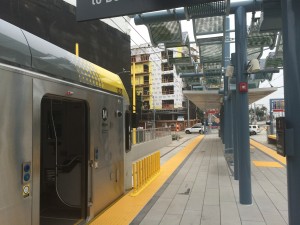
New apartments by the downtown Santa Monica station, which ain’t happening hear other stations along the Expo Line.
The Expo Line from Downtown L.A. to Downtown Santa Monica travels a highly congested corridor in the job-rich but housing-poor Westside of L.A. While the multibillion rail line has been successful so far in exceeding ridership projections, it could still fail to live up to its full potential unless the station neighborhoods allow more compact, rail-oriented development to generate enough riders for the line and minimize the taxpayer costs. Not to mention this part of town badly needs housing in areas that don’t require car commuting.
So it was a big deal last month when the City of Los Angeles released the draft Exposition Corridor Transit Neighborhood Plan, which governs the land use for the neighborhoods around the line within the City of Los Angeles.
Steven Sharp over at Urbanize LA took a deep dive into document. His verdict? The plans are tepid at best with no strong vision for the kind of density required to make good use of the multi-billion rail line:
While a small but significant step towards a more transit-oriented future for communities surrounding the Expo Line, the Expo TNP [transit neighborhood plan] falls short in terms of scale and scope when compared to planning around rail lines in other major cities.
On the opposite side of the country, Washington Metro stations are surrounded by dozens of walkable town centers in southern Maryland and northern Virginia. Other existing commercial hubs, such as Tyson’s Corner, are being gradually retrofitted for pedestrians following the introduction of passenger rail service.
In contrast, the proposed Expo TNP walks a fine line between maintaining the status quo and creating the transit-oriented communities implied by the project’s name. The station subareas which would be rezoned for higher density development represent less than 13 percent of the total land area encompassed by the Expo TNP, as the vast majority of properties are excluded from land use changes on account of their R1 and R2 zoning.
The properties that would be upzoned under the plan are almost exclusively commercial and industrial sites, where current occupants are less likely to oppose new construction. Although a change in land use may be appropriate for these properties due to the arrival of the Expo Line, the fact that wealthier residential blocks nearby were left untouched speaks to the continued political clout of Los Angeles’ homeowners. This is perhaps best highlighted by the Westwood/Rancho Park Station, which is surrounded on all sides by million-dollar houses, and was more-or-less ignored by the Expo TNP.
All of which makes me want to renew my call to shut down or otherwise reduce service to under-performing stations along the line. If the locals are not going to allow appropriate development in these choice areas, then these stations shouldn’t slow riders traveling from the dense downtowns on either end.
2 thoughts on “Expo Line Station Neighborhoods Have Weak Plans For Development”
-
Pingback: Today’s Headlines – Streetsblog Los Angeles
-
Pingback: Kotkin & Cox Blast L.A. Rail For Failing To Support Their Suburban Utopia | Ethan Elkind
Comments are closed.


